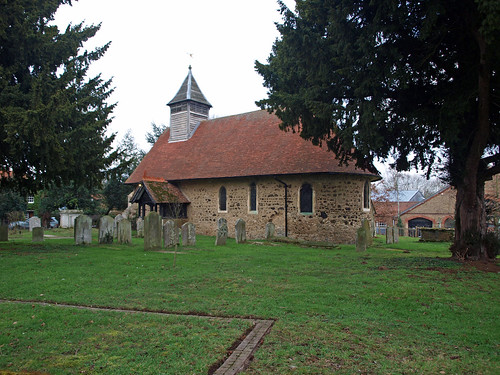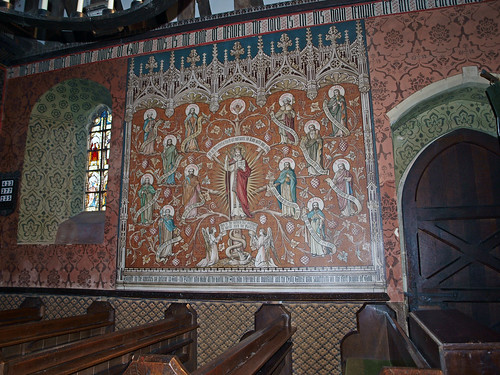Before the alterations to the church in the late nineteenth century, this must have been one of the smallest churches in the county. It was built about the year 1120 probably by Richard de Beaumes, Bishop of London. The orientation of the building is such that there is a perceptible inclination to the south-east, towards the point on the horizon where the sun rises on St. Nicholas Day (6th December). The walls are 2 ft. 8 ins. in thickness and are composed of flint·rubble with pudding stone. The only original Norman window left is the one on the north side of the apse, and similar windows may be found in other churches in this district. All the other windows have been enlarged and are of later periods, but it is possible that the single light window in the south wall although completely restored externally has a rear arch and splays of the twelfth century.
The porch was built in 1535 on the strength of a bequest (£4) by Thomas Roberts for that and other purposes. His parents are commemorated in a fine brass, let into the chancel floor, displaying the effigies of William Roberts, his two wives, and five daughters and with the following Latin inscription in Gothic characters:-
"Pray for the soul of William Roberts, formerly one of the Auditors of our Lord the King Henry VII and Joyce his wife, who was the daughter of Edward Peryent, Esquire, and of Margaret afterwards the wife of the said William who was the daughter of William Pyton, Knight. Which William Roberts died 8th October 1508. May God be merciful to their souls. Amen.”
The family, who lived in Little Braxted Hall, held the estate for several generations from 1480, the last resident member being the Thomas Roberts, died 1680, whose plain ledger slab is in the nave close to the chancel gate.
The roof of the chancel is modern, but incorporates a few old timbers. The fifteenth century roof of the nave has collar beams, purlins and wind braces. From 1730 to 1856 there appears to have been no resident rector and the church was allowed to fall into a very poor state of repair. Apparently some repairs were done in 1815 but the main restoration took place in 1856 when nearly £500 was spent on making the church sound and clean. Then in 1884 the church was enlarged by the removal of the north wall, the construction of an arcade of two arches and the erection of the north aisle. The old north door and the three old windows out of the old wall were re-used. The wall painting, which is largely allegorical, and the stained glass windows are the work of the Rev Ernest Geldart, rector 1881-1900.
ST NICHOLAS. Norman nave and apsed chancel. Of the windows original only one - in the apse. It is tiny. Two C13 lancet windows in the W wall. Another re-used in the N aisle which was added in 1884. C19 also the pretty half-timbered W gable and the renewal of the belfry. C15 roof starting very low above one’s head. - PLATE. Cup and Paten of 1567; Almsdish of 1683. - BRASS to William Roberts d. 1518, and two wives, with small kneeling children below; as usual.
LITTLE BRAXTED. Here the Blackwater river runs beneath the willows. A timbered house and a huge thatched barn have stood by the tiny church for nearly 400 years. Only 45 feet long, the church walls remain as the Norman builders left them, having completed one of those perfect apses which gave such charm to their early buildings. In the 13th century lancet windows were inserted and in the 15th century the roof was made new. Great beams support the wooden belfry. William Roberts is in brass on the chancel floor, with his two wives in pedimental headdresses and groups of their children. He was one of the precious auditors who served Henry the Seventh in restoring the finances of the nation after the Wars of the Roses. A last-century vicar has left his mark on the walls, which he decorated with his brushes and paints.
It should be noted that he also did the tiling, as in designed and installed. I think the reason I love his work is that he is so obviously sympathetic to the church and the quality of his work is outstanding.
Simon K -
To reach the next church I had a long haul, through Little Totham, North Great Totham, Little Braxted and almost to the A12 and the outskirts of Witham.
He was vicar here 1883-1900, so he had the opportunity to create a church which was entirely his, to his fashion and philosophy. He did this with no expenses barred, a fabulous confection of the pre-Raphaelite and proto-Art Nouveau.
Every surface is painted, every wooden object is gilded, there are statues and stained glass and every thing, an absolute treasure house.
Open every day, it makes a mockery of churches which are kept locked. It is awe-inspiring, if not perhaps quite to the modern taste, and went immediately into my Essex Top 20.
To reach the next church I really needed to go back two miles to Little Braxted, but on my OS map there was a bridleway beyond the mill, which proved a decent surface for cycling except for about a hundred yards, and took me two miles to the edge of Braxted Hall.
Flickr set.



No comments:
Post a Comment